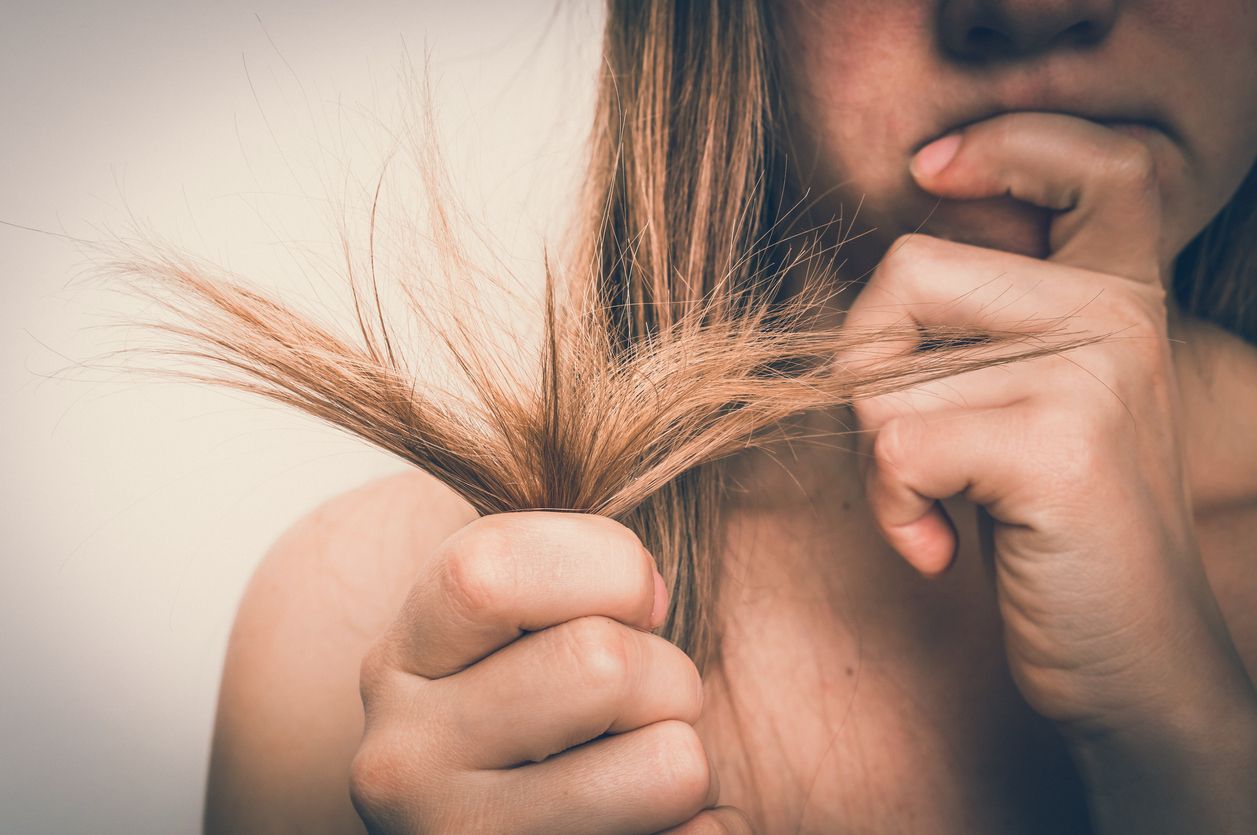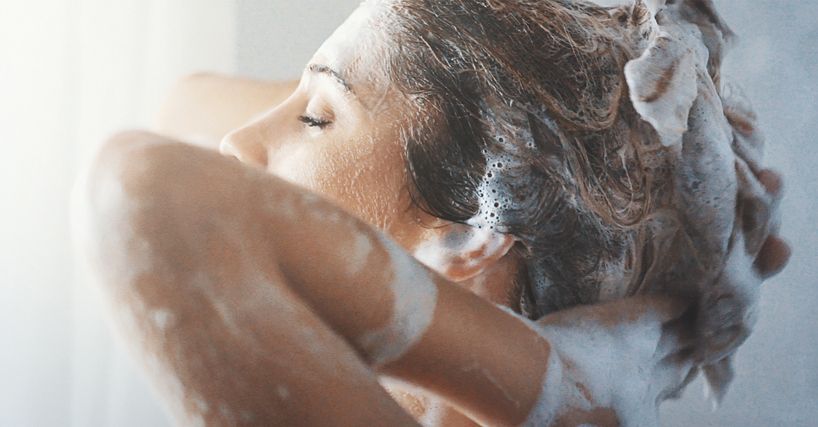
Author: Natalie Ng|Updated: 27 May 2025
Hair goes through a lot more than we realize while we sleep. Tossing, turning, and rubbing against the wrong fabric can wear down your hair strands without you even noticing. Over time, this can lead to breakage, dryness, and split ends—especially if you already have thin or damaged hair. You don’t need a complicated routine to protect your hair overnight. Small changes like switching to a silk or satin pillowcase, wrapping your hair loosely, or avoiding tight hairstyles before bed can make a real difference. Even something as simple as letting your hair dry fully before sleeping can help reduce friction and keep your hair health in check. If you’ve been wondering how to prevent hair breakage during sleep, especially if you often wake up with tangled hair or notice more shedding, it’s worth looking at your bedtime habits. Keep reading for seven easy ways to care for your hair while you sleep—no extra effort needed.

Signs Your Hair Is Breaking While You Sleep

Damage can build up overnight without you noticing
Hair breakage often happens slowly and without obvious signs at first. While you might not see major changes day to day, small signs can point to damage developing while you sleep. Paying attention to these clues helps you take action before breakage becomes more visible or harder to manage.
Early signs of overnight hair breakage:
• More hair on your pillowcase, bonnet, or scarf in the morning
• Dry, brittle ends that feel rough even after applying products
• Split ends or short, uneven pieces that weren’t caused by a haircut
• Knots or tangles that form overnight, especially near the nape or ends
• Baby hairs or flyaways that break easily when brushed
• Dull or frizzy texture that worsens after sleeping
These signs usually come from friction, moisture loss, or tension caused by the way your hair is handled overnight. If you're seeing any of these regularly, the following habits can help protect your hair while sleeping and support long-term hair health.
Stop Hair Breakage With These 7 habits!

Habit 1: Switch to a Silk or Satin Pillowcase

Cotton fabrics increase friction and damage the hair shaft
Sleeping on a cotton pillowcase can cause more harm to your hair than you might expect. The texture creates friction as your head moves during sleep, which weakens the hair shaft and leads to breakage over time. It also absorbs natural oils from your scalp, which dries out your hair and makes it more prone to split ends, especially for those with thin hair, long hair, or already damaged hair.
Benefits of using a silk or satin pillowcase
Silk and satin create a smooth surface that helps reduce friction between your hair and the pillow. This keeps your strands from getting pulled or tangled while you sleep. It also helps your hair stay moisturized overnight, since these fabrics don’t soak up oil the way cotton does. Whether you have soft waves, a blowout, or natural curls, sleeping on silk or satin helps protect your hair from unnecessary damage.
What to use and how to care for it
• Look for a silk pillowcase with at least 19 momme weight
• Choose a satin pillowcase with a minimum 300-thread count
• Wash it in cold water with a gentle detergent to maintain softness
• Pair it with a loose braid or use a satin scrunchie to keep hair loosely tied without pulling
• Avoid going to bed with wet hair, as damp hair is more prone to breakage during movement
Date should not be before minimal date

Habit 2: Choose a Loose Protective Hairstyle Before Bed
Loose braids reduce friction and prevent tangled hair
Hair can break easily at night from constant movement and contact with your pillow. A loose protective hairstyle helps keep your strands in place without creating strain. Styles like a single loose braid or two soft side braids allow your hair to rest gently, lowering the chance of friction and tangles while you sleep.
Loose braiding keeps hair grouped together without pulling at the scalp or stretching the strands. This reduces the risk of split ends and supports the natural shape of your hair. Protective hairstyles also help control long hair, keeping it from rubbing against your bedding, which can lead to dryness and hair shaft damage.
Gentle accessories protect your hair overnight
• Skip tight elastics that grip too firmly and use satin scrunchies or soft cloth ties instead
• Secure your braid without over-tightening—the hold should feel comfortable and relaxed
• Wrap your hair loosely at the crown or nape if you prefer a simple gathered style
• Add a silk or satin scarf or bonnet to help your style stay in place while reducing moisture loss
These simple tools and methods give your hair a chance to rest overnight without pulling or stress. They’re especially helpful for thin hair, soft waves, or ends prone to splitting.
Tight hair ties increase breakage and scalp tension
Hair ties that grip too tightly can place constant pressure on the strands. Over time, this weakens the hair shaft and may lead to breakage near the roots or ends. Even lightweight elastics can cause damage if they’re too snug or used repeatedly in the same spot.
Use accessories that allow natural movement without slipping out of place. A soft satin scrunchie or spiral tie holds your hair securely but gently. Position your style about 2 to 3 inches from the scalp to avoid pulling, especially during sleep. This helps reduce the stress placed on the hair follicles and supports better hair health overnight.

Habit 3: Deep Condition Hair Before Bedtime
Moisture helps reduce friction and hair shaft damage
Keeping your hair moisturized at night is one of the most effective ways to protect it from breakage. Dry strands are more likely to snap, especially when rubbed against fabric or styled tightly. Deep conditioning before bed gives your hair the hydration it needs to stay strong and flexible while you sleep.
Apply your treatment to damp hair—not soaking wet—and work it through in sections for even coverage. A deep conditioner that includes natural oils, humectants, or proteins can help repair weakened strands and support long-term hair health. Gently warming the product between your hands allows it to absorb better into the hair shaft.
Moisture application timing improves results
• Apply your deep conditioner 2 to 3 hours before bed to avoid sleeping with wet hair
• Divide damp hair into four sections for easier application
• Work in small, 1-inch wide pieces to ensure full coverage from root to tip
• Let it sit for 30 minutes before rinsing with cool water
After rinsing, follow with a leave-in conditioner to help lock in moisture. Use a small amount—about a quarter-sized portion for shoulder-length hair—so the product doesn't weigh your hair down. Your strands should feel soft, not greasy or heavy.
Choosing the right leave-in conditioner for your hair type
Leave-in products vary in texture and ingredients. What works depends on your hair’s thickness, porosity, and how it reacts to moisture. Lightweight, water-based treatments are best for fine or thin hair, while thicker hair can handle richer formulas with natural oils like coconut oil or shea butter.
If you're unsure what to use, test your hair's porosity by placing a clean strand in water. If it floats, go for lighter products. If it sinks, use heavier, moisture-rich options. Start small and focus on the ends first, as they tend to be the driest and most fragile part of the hair.

Habit 4: Apply an Overnight Hair Oil Treatment
Lightweight oils strengthen and protect hair strands during sleep
Overnight oil treatments support hair repair by locking in moisture and reducing friction while you sleep. When applied properly, oil creates a protective layer around the hair shaft, helping to prevent dryness, tangles, and split ends. Start with clean, slightly damp hair to help the oil absorb more effectively.
Choose lightweight oils like argan oil, grapeseed oil, or jojoba oil. These absorb quickly and won’t weigh your hair down or stain your pillowcase. Avoid thick or heavy oils unless your hair is very dry or coarse.
Use only a few drops, warming them between your palms before applying. Focus on the mid-lengths and ends, where breakage is more common. The goal is to coat the hair lightly—your strands should feel soft and smooth, not oily or heavy.
Oil application tips for overnight use
• Start with 2 to 3 drops for fine or short hair; use more only if your hair is thick or dry
• Apply the oil evenly, avoiding the scalp unless it's dry or flaky
• Use a silk or satin pillowcase or wrap your hair with a silk scarf to avoid product transfer
• Repeat 2 to 3 times a week depending on your hair type and how much moisture it needs
This method helps reduce overnight damage while giving your hair extra nourishment. By morning, your strands will feel softer and more manageable, with fewer signs of breakage or dryness.
Date should not be before minimal date

Habit 5: Use a Hair Bonnet or Silk Scarf While Sleeping
Smooth fabrics reduce friction and help retain moisture
Wrapping your hair with a silk bonnet or satin scarf creates a protective barrier between your strands and your bedding. Unlike cotton pillowcases, which cause friction and absorb natural oils, smooth fabrics like silk and satin allow your hair to move freely without catching or drying out. This simple step helps reduce split ends, frizz, and hair shaft damage while keeping your hair moisturized overnight.
A hair wrap also helps preserve any overnight treatments, such as oils or leave-in conditioners, by holding moisture in and preventing product from rubbing off onto your pillow.
Proper fit and wrapping technique
• Choose a bonnet or scarf that fits securely but feels comfortable
• If using a silk scarf, fold it into a triangle and tie it at the nape of your neck
• Make sure all hair is tucked inside, including shorter layers and baby hairs
• Use a satin bonnet if your scarf tends to slip off during sleep
This protective layer works well for all hair types and textures, especially if you’ve styled your hair in loose braids, twists, or soft waves before bed. It also helps maintain smoothness and prevents overnight tangles.

Habit 6: Dry Your Hair Completely Before Going to Bed
Damp hair increases risk of breakage and scalp issues
Hair is at its weakest when wet. Going to bed with damp hair leaves it vulnerable to breakage, tangling, and even scalp problems. Wet strands stretch more easily, and when pressed against a pillow for several hours, they can snap or fray at the ends. Sleeping with wet hair may also trap moisture against your scalp, creating an environment for buildup or irritation.
Making sure your hair is completely dry before bed helps protect its structure and reduces overnight damage. It also supports better scalp health and lowers the risk of developing split ends caused by excess friction.
Best ways to dry your hair before sleep
| Drying Method | Time Needed | Best For |
|---|---|---|
| Air Drying | 2–3 hours | Natural waves, no heat |
| Blow Drying | 10–15 minutes | Quick results |
| T-Shirt Wrap | 30–45 minutes | Fragile or thin hair |
Air drying works best if you finish washing your hair a few hours before bedtime. If you’re short on time, use a blow dryer on medium heat, keeping it at least 6 inches from your scalp. Always apply a heat protectant to reduce the risk of heat-related damage. Gently pat your hair with a microfiber towel or soft t-shirt to remove excess moisture before drying.

Habit 7: Detangle Hair Gently Before Bed
Proper detangling prevents stress on the hair shaft
Tangled hair is more likely to break while you sleep, especially if it rubs against fabric or gets caught in itself. Taking time to detangle your hair before bed reduces pulling and helps keep strands smooth through the night. This small step is especially important for long hair, textured hair, or hair that tangles easily.
Use a wide tooth comb or a detangling brush made for gentle use. These tools help separate strands without causing unnecessary stress or pulling at the roots. Always detangle dry or lightly damp hair—never soaking wet—to lower the risk of hair shaft damage.
Tools and techniques that protect your hair overnight
• Section your hair into four parts using clips or soft ties to make detangling more manageable
• Start from the ends and work your way up slowly—this helps avoid tugging or snapping strands
• Hold each section gently while combing to reduce strain on the scalp
• For knots that resist the comb, use your fingers first before brushing through
• Apply a leave-in conditioner or detangling spray to create slip and make brushing easier
Date should not be before minimal date

Nighttime Hair Care Checklist
Simple steps to protect your hair while sleeping
A solid nighttime routine doesn’t need to be complicated. Sticking to a few small habits can help prevent breakage, reduce friction, and support healthier hair in the long run. Use this checklist as a quick reminder before bed—especially if you have long hair, thin hair, or are noticing signs of hair damage.
Before going to sleep:
• Make sure your hair is completely dry
• Detangle gently with a wide tooth comb
• Apply leave-in conditioner or hair serum if needed
• Use a satin scrunchie or soft tie—never tight elastics
• Style your hair in a loose braid, messy bun, or soft pigtail braids
• Wrap your hair in a silk bonnet or satin scarf
• Rest your head on a silk or satin pillowcase
• Avoid going to bed with freshly applied heavy oils unless wrapped properly
• Skip tight hairstyles that put pressure on the scalp
• Use a blow dryer on medium heat if you need quick drying—always with a heat protectant
By following these small steps regularly, you can help protect your hair overnight and wake up with smoother, stronger strands.

Boost Hair Strength and Reduce Breakage with F8 Hair Regrowth Treatment
Keeping your hair protected overnight is important—but sometimes, the root of the problem starts deeper than your pillowcase or hairstyle. If you’re already noticing signs of hair breakage, thinning, or reduced volume, external care alone may not be enough. That’s where in-salon scalp and hair treatments like F8 Hair Regrowth Treatment come in.
This non-invasive treatment supports your hair’s health from the inside out, making your strands more resilient to everyday damage—including the kind that happens while you sleep.
What F8 Hair Regrowth Treatment Does for Your Hair
F8 combines low-energy laser therapy with hair growth serum infusion to target the scalp, hair follicles, and surrounding capillaries. The laser energy activates inactive follicles and stimulates the hair papilla, while the serum hydrates, cleanses, and helps balance oil levels on the scalp.
Together, these effects create a healthy scalp environment that supports hair growth, strengthens the hair shaft, and improves hair quality—making it less likely to break during sleep or styling.
Benefits That Support Hair While Sleeping
• Improves hair density and structure, reducing the risk of breakage caused by friction or tight hairstyles
• Promotes blood circulation, helping deliver more nutrients to the follicles for better growth and stronger strands
• Balances scalp oils, preventing excess sebum and clogged follicles that can weaken hair at the root
• No downtime or irritation, making it safe for regular use alongside your daily and nighttime hair care routine
• Reduces signs of hair loss, which supports long-term scalp and hair health for both men and women
When used alongside habits like protective hairstyles, silk pillowcases, and gentle detangling, F8 helps reinforce your hair’s strength—so it holds up better through the night and beyond.
Ready to give your hair the support it needs? Book your F8 Hair Regrowth Treatment today and start seeing the difference in how your hair feels and grows.
F8 Hair Regrowth TreatmentDate should not be before minimal date
FAQ
1. Can sleeping with a messy bun cause hair breakage?
Yes, a messy bun can lead to breakage if it's tied too tightly or secured with a rough hair tie. Sleeping with tension on the hair shaft—especially near the crown or hairline—can cause strands to snap. If you prefer a bun at night, use a soft scrunchie and keep it low and loose to reduce pressure on the scalp and avoid pulling on the hair follicles.
2. Does a satin pillowcase really help with hair growth?
A satin pillowcase doesn’t directly stimulate hair growth, but it helps prevent the friction and moisture loss that can lead to breakage and damage. By keeping the hair shaft smooth and reducing friction while you sleep, satin or silk pillowcases create a better environment for maintaining hair health, which supports long-term hair growth.
3. What’s the best way to sleep with damp hair without causing hair breakage?
If you have to sleep with damp hair, use a wide tooth comb to detangle it gently, then loosely braid or tie it using a satin scrunchie. Avoid tight hairstyles, and always rest your head on a satin or silk pillowcase to reduce friction. You can also lightly apply a leave-in conditioner or a small amount of hair serum to keep the hair moisturized while preventing tangles and split ends.
4. Do certain sleep positions reduce hair breakage?
Yes, your sleep position can affect how much your hair rubs against the pillowcase. Sleeping on your back generally causes less friction than sleeping on your side or stomach. If you tend to move around a lot, wrapping your hair in a silk bonnet or using a silk scarf helps protect your hair overnight, regardless of position.
5. How often should I change my silk or satin pillowcase to maintain hair health?
To maintain a clean surface that supports healthy hair, wash your silk or satin pillowcase once or twice a week. This helps remove natural oils, product buildup, and bacteria that can irritate the scalp. If the fabric starts to feel rough or shows signs of wear, consider replacing it every 6 to 12 months to keep the friction low and your hair protected while sleeping.
Recommended Articles
COPYRIGHT© NEW BEAUTY MANAGEMENT LIMITED 2025. ALL RIGHT RESERVED.




